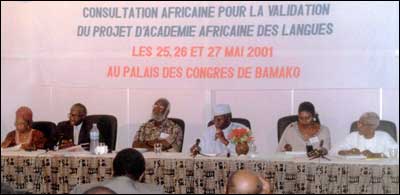|
 A
BRIEF SURVEY OF THE IMPLEMENTATION OF THE RECOMMENDATIONS, RESOLUTIONS,
DECISIONS, PLANS AND PROGRAMMES ON AFRICAN LANGUAGES AT THE
GOVERNMENTAL LEVEL: THE CASE OF THE OAU A
BRIEF SURVEY OF THE IMPLEMENTATION OF THE RECOMMENDATIONS, RESOLUTIONS,
DECISIONS, PLANS AND PROGRAMMES ON AFRICAN LANGUAGES AT THE
GOVERNMENTAL LEVEL: THE CASE OF THE OAU
By Marcel DIOUF
1. The OAU Charter (1963)
Article 29 of the OAU Charter states that the working languages
of the Organization are, if possible, African languages as well
as English, Arabic, French and Portuguese.
From 1963 to 1991, only the Heads of State of Ethiopia have
used an African language (Amharic) at the OAU. This document
has not, however, been translated into any African language.
2. The pan-African cultural Manifesto of Algiers (1969)
The Manifesto was the first document adopted by an experts'
meeting called under the auspices of the OAU which makes recommendations
for the promotion of African languages. These recommendations
bear essentially on the:
. translation of the major works of humanity on African languages
and of outstanding
African works in the major international languages;
. use of African languages in teaching.
The actual implementation of these recommendations (translation
of major works) is very limited.
3. The Final Report of the Intergovernmental Conference
on Cultural Policies in Africa (UNESCO-OAU.) 1975 Accra, Ghana
This Conference can be considered the starting point of post
colonial cultural (and linguistic) policies in Africa. The resolutions
and the declarations adopted at this conference were materialised
at the governmental level by the establishment or the reinforcement
of regional centres such as the CELHTO, the EACROTANAL, the
CICIBA, the CERDOTOLA, etc.
 4. The Cultural Charter for Africa adopted by
the OAU. July 1976, Port-Louis -Mauritius 4. The Cultural Charter for Africa adopted by
the OAU. July 1976, Port-Louis -Mauritius
This document combines the draft Cultural Charter proposed by
the African Cultural Institute (ICA) and the recommendations
of the panafriacn cultural Manifesto of Algiers.
The three articles devoted to African languages have also had
some impact on the development of regional centres. Yet, they
did not bring any significant change in the actual use of African
languages in intergovernmental instances. This document was,
however, translated by the OAU in some African languages.
5. The Lagos Plan of Action for the Economic Development
of Africa (1980)
This document makes no reference to African culture, let alone
African languages which are, nonetheless, factors of development.
6. The results of the OAU 1st Conference of African Ministers
of Culture 1986, Port-Lous Mauritius.
This conference adopted two important documents:
a) The Language Plan of Action for Africa produced by the Interafrican
Bureau of Languages BIL/OAU (Kampala, Uganda).
b) Resolution N° 16 on the adoption of Kiswahili as an OAU
working language.
The final report and the resolutions adopted at this conference
were approved by the OAU Summit of Heads of State and Government
in July 1986 in Addis Ababa. Unfortunately:
- the resolution on the use of kiswahili has never been
implemented by the OAU, nor by any other African intergovernmental
organization;
- the language Action Plan has not had any visible impact
on the practical uses of language in African governmental
organizations;
- the Inaugural Convention of the Panafrican Association
of linguists has not been held yet, in spite of
- the calling of two preparatory meetings in Addis Ababa
(1988) and Tunis(1993)
- the Interafrican Bureau of Languages (BIL), set up by
the OAU in Kampala, was closed in 1987.
7. The Abuja Treaty establishing the African Economic
Community. 1991, Nigeria.
This major document (just like the Lagos Action Plan) constitues
a setback concerning the OAU Charter (1963). It eliminates African
languages from the list of the working languages of the African
Economic Community.
8. The regional Plan of oral traditions gathering in Southern
Africa. 1993, Harare -Zimbabwe.
This regional plan adopted by an experts' meeting called by
the OAU has never been implemented and the proposed creation
of a regional centre equivalent to the CELHTO, the EACROTANAL
or the CERDOTOLA in Southern Africa (OTASA) has never been realised.
9. The Intergovernmental Conference on Language Policies
in Africa (UNESCO-OAU-ACCT). 1997, Harare -Zimbabwe.
The recommendations, the declaration and the Language Plan of
Action for Africa adopted at this conference haven't had any
visible impact on the use of languages in African intergovernmental
organisations. Following this conference the UNESCO Language
Unit was closed.
10. The redynamisation of the EACROTANAL. 1997
The attempts to redynamise this regional centre based in Zamzibar
(Tanzania), begun with the Harare conference (1997), have failed.
11. The Programme of Action of the Decade of Education
in Africa. 1999, Harare -Zimbabwe
The provisions of this OAU document concerning the use of African
languages in education have not changed in any significant way
the ongoing practices of the countries and organisations of
the continent.
12. The Treaty establishing the African Union. 2000, Lome
-Togo
This document which replaces the OAU Charter (1963) reintroduces
the possibility of using African languages as working languages
of the OAU.
13. The African Academy of Languages.
The establishment of the Academy is justified given the shortcomings
mentioned above. It will have, among other roles, to identify
the real reasons for the failure to use African languages in
African intergovernmental organisations, and propose solutions.
|